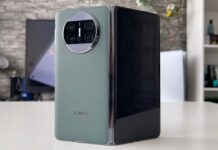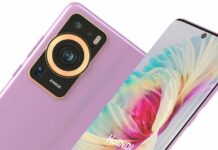Huawei Mate X was one of the best foldable phones of 2019, not that there was a large amount of them. It was also rather hard to come by, especially internationally. Now there’s an internationally launched successor, Huawei Mate Xs, which gets a new CPU, but keeps the design and many of the specs of the OG model. It was unveiled in Barcelona on February 24th and we got some quality time with it for 48 hours. The result can be seen below, in a detailed hands on review.
Among all the foldables we’ve tested this comes the closest to a REAL iPad Mini alternative. It’s actually bigger in diagonal, but more compact somehow. Compared to the Mate X it also gets 5G, a new CPU and slightly improved Falcon Wing hinge. Let’s see what it can offer for 2499 euros!
Design
When opened up, the phone provides an 8 inch diagonal screen, while closed it provides a main 6.6 inch display. There’s also a back 6.38 inch display, but that one is only used for selfies. The hue seen here is Interstellar Blue and the Mate Xs weighs 300 grams. Yes, it’s very heavy for a phone, especially since we also complained about 220 or 240 gram phones already. You need to understand that there are complex mechanisms at work here and you actually get two phones in one.
When closed, the phone measures 11 mm in thickness, while when open it shocks with a 5.4 mm waistline. The main portion with the components is the “stub” as I like to call it, where there’s the CPU, quad camera and other vital components. You will grab hold of it, like you did with the Lenovo Yoga tablets. The device is very rounded on its edges when closed, which makes it rather slippery> Buttons are comfy, but the screens are external, so they’re exposed to scratches, with only a plastic protection applied from the factory.
Huawei Mate Xs opens in an opposite way from the Galaxy Fold. It actually spends all of its time folded and unfolds when you want a bigger screen. There’s a Falcon Wing hinge much better hidden than the other foldables. You need to press a special button below the camera to pop open the half of the screen folded behind the main one. Luckily there’s no crease or visible fold here, unlike the Galaxy Fold and Z Flip. There may be a slight “hill” in the middle of the display, but if you really straighten the panels it’s gone.
It feels like the comfiest tablet in the world, but it’s still a very heavy phone. There’s no air gaps between the screens and the engineering is discrete and smart. It combines glass, metal and plastic.
Display
Huawei Mate Xs has an 8 inch OLED screen when opened, with a resolution of 2480 x 2200 pixels, but in phone mode it provides an OLED 6.6 inch 2480 x 1148 pixels. The secondary screen is just for selfies and it provides a resolution of 2480 x 892 pixels. We watched a YouTube video on the opened screen and experienced a high level of brightness, deep blacks, wide angles and a decent contrast. It’s a pleasing experience, but it leaves black bars on the sides, on account of the square format.
If you crop to make the image fill the screen, you may cut off the characters’ heads or other parts. The colors are very vivid and the details are all there. Settings for the screen include brightness, Color Mode (Normal or Vivid), color temperature (warm or cold). There’s also Dark Mode, Eye Comfort, text size and app scaling. I would also have to say that the bezels are pretty thick.
Hardware/benchmarks
Inside we find the new Kirin 990 5G CPU, also seen on the Huawei Mate 30 Pro 5G. It’s a 7 nm octa core CPU, with a 16 core Mali G76 GPU and an NPU. There’s also 8 GB of RAM, although I expected 12 and 512 GB of storage. There’s also a proprietary Huawei Nano Card slot, with up to 256 GB storage. I’d say that in spite of us handling a prototype, there was no lag and it all worked fine. Asphalt 9 looks mint, with the rain effects and all, plus I feel that I got more details than the last time I saw the game on a flagship.
There’s no overheating here, in benchmarks or fast charging.
We did few benchmarks, but the results were rather good. In 3DMark Slingshot Extreme ES 3.1, the device scored third spot, only behind the ASUS ROG Phone II and ZTE Nubia Red Magic 3S. It’s above the Galaxy Fold by 5 points, above the Mate 30 Pro and iPhone 11 Pro Max. We also have some browser benchmarks, which are on par with the Android flagships, but inferior to the iPhone 11 Pro Max.
Battery
There’s a 4500 mAh battery here, made out of two 2250 mAh segments, like the predecessor had. There’s 55W fast charge here, but it requires a special USB cable and charger. One thing’s dead sure: a 30 minute charge gives you 85% battery. We used the Mate 20 Pro charger we had and charged up the phone in less than 1 hour. Now, the battery life is much better than other foldables, including Galaxy Fold. You may reach a day of use for certain.
However, if you add 5G and keep the whole 8 inch screen opened, you may lose a few hours.
Audio
Huawei Mate Xs only has a singular speaker at the bottom, which seems like it’s going to be covered with your hand in landscape or regular use, but it doesn’t muffle the sound when you do that. There’s no audio jack and the speaker is quite loud and covers all the highs, mids and lows. There’e enough bass for my rap and dubstep taste, plus there’s no distortion. Even though the device is just 5.4 mm in thickness, there’s no major vibrations of the body at top volume.
I loved the music, game and movie experience and totally regret the lack of stereo speakers. I’d even say we go past 100 decibels in games.
Camera
First of all, there’s no selfie camera here, in order to keep a clean front side, where the Galaxy Fold had an ugly notch. There is however a back quad camera, also usable for selfies, thanks to the secondary screen. The main cam has the following sensors:
- 40 MP, main camera, F/1.8
- 16 MP, ultra wide camera
- 8 MP, telephoto camera, OIS, possibly 3x optical zoom
- ToF 3D sensor
There’s also Leica optics, 4K 60 FPS video capture, Monochrome, 32X Slow Motion, Light Painting, Portrait with multiple filters, Master AI and a Super Macro mode. The camera UI isn’t very comfy on account of having a slider for the zoom. I would have liked separate steps at wide, 3x, 5x and we actually have that but they’re too small for my fingers. Zoom goes to 30x by the way. There’s no periscope camera here, but I’m willing to bet we have the zoom camera of the Mate 30 Pro and P30 Pro.
As far as the photo gallery goes, the photos were taken on a pretty cloudy day in Bucharest. I actually enjoyed the selfies a lot, which is because they’re very detailed, having been taken with the main camera. There’s a perfect skin texture, lots of details, nice colors and clarity. With Beauty off the skin looks tangible. Bokeh separation of the foreground and background was great as well. I feel that it’s miles above the Mate 20 Pro and iPhone 11 Pro in Bokeh separation, maybe equal to the Note 10+.
We tried out some Super Macro shots on flower buds, to great results, making small objects appear larger and more detailed. Back to the selfies for a bit, clothes and hair have a lovely texture, reminding me of what Apple bragged about with the Fusion/NPU thing. Zoom was lossless up to 5x, afterwards things got noisy. I think that a firm hand or tripod could get great results even at 10x.
There’s also some Leica filters here, for extra vivid colors, on that gloomy cloudy day. Ultra wide capture is a bit whiter than the main camera capture, but it doesn’t curb, deform the image or create color mishaps. It’s not as wide as a Samsung phone capture, though. Colors were pretty well calibrated, realistic and we also have some nice closeups of objects, even though some of them were hard to pull off on account of the focusing.
I feel that the whole capture quality fits between the P30 Pro and Mate 30 Pro. I should probably mention we had a prototype here, so the software was not final, that’s why some pics are darker than they should be. At last we also have 4K 60 FPS video capture on a Huawei phone, but stabilization isn’t great. The image gets “waves” and that may also happen when you stay put. Clarity is OK, colors are on point, the focus test was excellent and above the Galaxy Z Flip in speed and accuracy.
Nice details n the distance and exposure setup, plus dynamic range. Selfie videos have excellent focus, skin clarity, but poor stabilization. The 3 microphones handled the wind OK, but this thing needs a software patch for the image “Waves” and stabilization, I guess. We’re waiting on the final unit.
Connectivity
Huawei Mate Xs comes with 5G connectivity on the first SIM slot and 4G on the second one. There’s also WiFi dual band, GPS, Bluetooth 5.0, an USB-C 3.1 port and infrared emitter at the top. You can use that to control set top boxes, TV sets and air conditioners, plus more. There’s no audio jack, but there are 3 microphones on board. Huawei did a fine job at hiding the earpiece on this device.
OS, UI, Apps
Huawei Mate Xs runs on Android 10 with EMUI 10 on top, but no Google Services or Google Play Store. There are still Huawei Mobile Services and App Gallery, plus we had Aptoide and APK Pure available. Do they fill in the blanks? Not all of them, since Netflix runs in 480 tops, you can’t use Uber or Google Maps. Alternatives are coming. The fingerprint scanner unlock was fast and easy, with the sensor on the side, in the Power button. The UI is very much as we left it on the Mate 30 Pro.
There’s a Today area to the left with news and useful shortcuts, plus apps and a search bar. Multitasking is a carousel of thumbnails and somehow for us the split screen didn’t work, but instead we got a floating app. Once again, we had a prototype. There’s also a side bar with apps for multitasking. We used App Gallery from Huawei to download apps, including games and they’re getting to be more and more by the day. There’s also Quick Settings at the top, with Dark Mode, Huawei Share and more useful options.
I used Huawei Share to mirror the device’s screen on a MateBook laptop, in real time and with excellent frame rate. Then there’s Optimized to clean resources and we played Asphalt 9 at the end of the review. Interestingly Mate Xs lacks the software gimmicks of other foldables: Galaxy Fold splits the screen in 3, Galaxy Z Flip has Flex Mode and Moto RAZR 2019 has the old school RAZR V3 mode.
Verdict
Pros:
- you don’t need a 7, 8, 9 inch tablet
- solid camera
- bright, big screen
- 5G
- good performance
- no crease on the foldable screen
- very fast charging
- loud speaker
- comfier than iPad Mini
- OK battery
Cons:
- heavy, at 300 grams
- no Google Services, Play Store
- just one speaker
- rounded and slippery body
- no screen protection for the exposed screen aside from plastic
- you’ll definitely cover the camera with your hands
With 5 foldable phones available on the market, things are getting into a stride. Mate X wasn’t widely available though, so if you want a bigger diagonal and a more productivity oriented device, Mate Xs is for you, particularly since it also has 5G. It chargs very fast and has no crease. It’s still a heavy machine, closer to a tablet than a phone, but the thing felt solid every step of the way. I’d totally give up my iPad Mini for this phone and I’d see myself doing daily activities on it if we had all Google Services replaced. It lacks the playfulness of clamshell foldables, but it’s more serious, enterprise oriented than Galaxy Fold.
We look forward to seeing the commercial version. The price of this device is 2499 euros, by the way.







